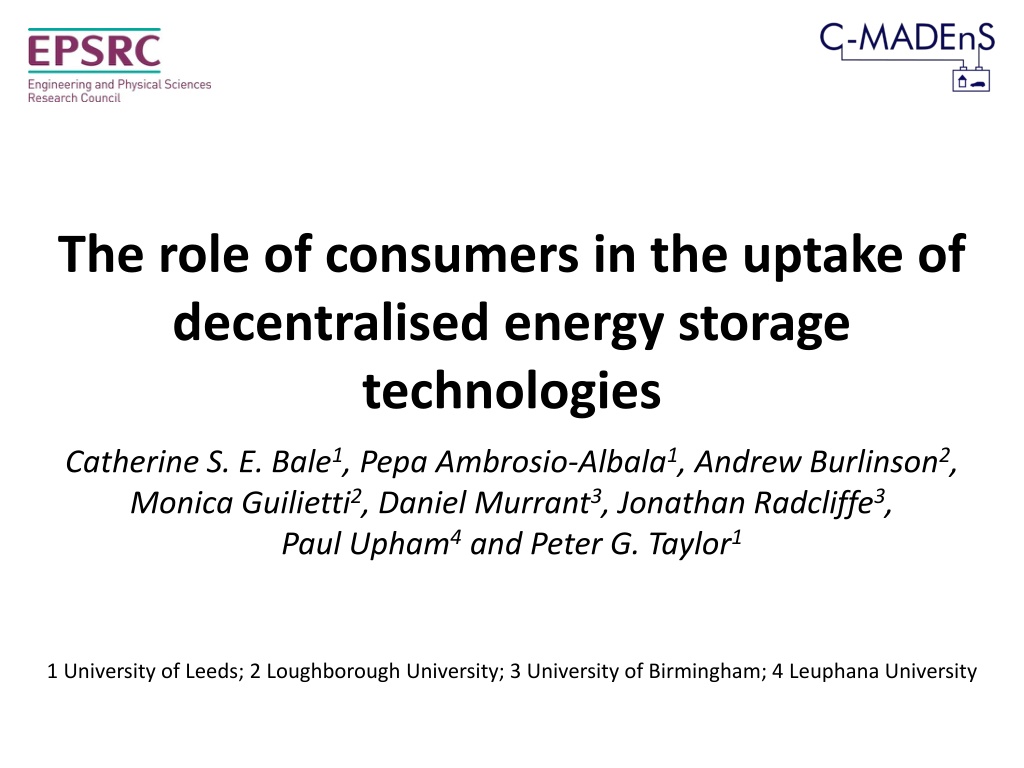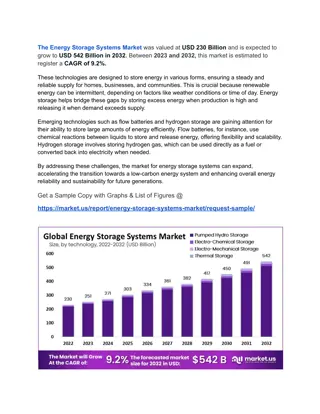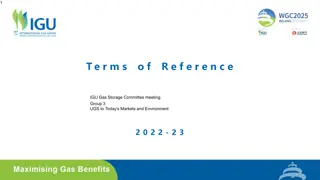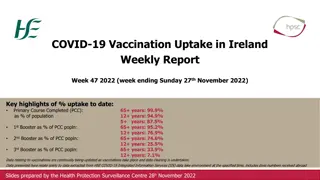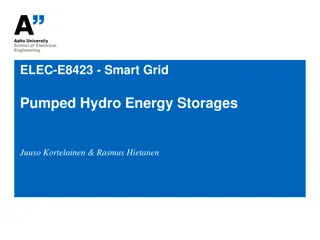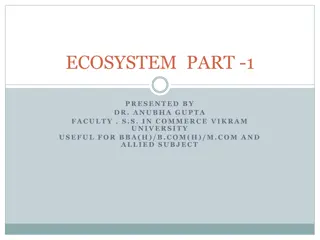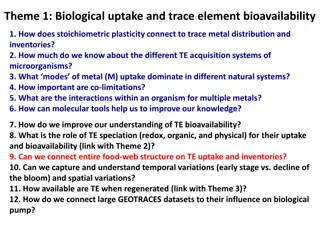Understanding Consumers' Role in Decentralised Energy Storage Uptake
Decentralised energy storage technologies offer solutions to increasing energy demand and integrating low-carbon sources. This research explores public perceptions, business models, and regulatory barriers related to consumer adoption of household and community-scale storage. By combining focus groups, surveys, and interviews, the study aims to understand the potential impact of consumers in shaping the future of energy storage.
Download Presentation

Please find below an Image/Link to download the presentation.
The content on the website is provided AS IS for your information and personal use only. It may not be sold, licensed, or shared on other websites without obtaining consent from the author. Download presentation by click this link. If you encounter any issues during the download, it is possible that the publisher has removed the file from their server.
E N D
Presentation Transcript
The role of consumers in the uptake of decentralised energy storage technologies Catherine S. E. Bale1, Pepa Ambrosio-Albala1, Andrew Burlinson2, Monica Guilietti2, Daniel Murrant3, Jonathan Radcliffe3, Paul Upham4and Peter G. Taylor1 1 University of Leeds; 2 Loughborough University; 3 University of Birmingham; 4 Leuphana University
Overview Background Research aims Methods Results Conclusions
Background Decentralised energy storage (DES) could play an important role in addressing the twin challenges of meeting increased energy demand and integrating new forms of low carbon energy supply. DES can deliver services including: matching supply and demand over periods from seconds to days; maximising the utilisation of existing and new infrastructure; providing links between heat and electricity systems and ensuring secure energy supplies. To date, the technical development of DES has received a lot of attention - with new technologies (e.g. Tesla Powerwall) and aggregation platforms (e.g. Moixa s GridShare) now available. However, we have a limited understanding of the role that households and communities could play in owning or using DES. The EPSRC funded C-MADEnS project has been undertaking interdisciplinary research on DES for the last three years.
Aims of the research To explore the role of consumers in the potential uptake of household and community-scale storage. Focus on three distinct but interlinked aspects: 1) public perceptions of decentralised energy storage; 2) the likely non-traditional business models that will be appropriate for household ownership or use of storage; and 3) the policy and regulatory barriers that these business models may face. Image result for solar panels Image result for housing leeds
Household & community batteries PV but no battery PV with individual battery PV with community battery PV with linked batteries Source: Andrew Pimm
Methods Mixed methods approach combining: Four focus groups with the public; Nationwide survey of 949 households; Reviews of business model case studies and international energy storage policy; Semi-structured interviews with storage technology developers. To understand public perceptions we applied an approach based on the Energy Cultures Framework (ECF) (Stephenson et al, 2010).
Understanding public perceptions HAVE THINK DO Energy Cultures Framework (Stephenson et al, 2010)
Results: public perceptions (1) The general public is not currently well informed about either household or community-level DES. Only 19% of people were familiar or very familiar with energy storage in the home or community Both local and central government are seen as playing an important role in delivering credible information and practical support to help householders adopt the technology or in delivering community-level schemes. Female 4: Yeah, for your needs, the needs of your house, you know; this is how much electricity your solar panels have created; this is how much you ve used. ( ) to kind of assess how you live for a week, to see the peaks and troughs, when you use your electricity, to be able to work out that way what would benefit you better, using the electricity. Male 5: It would be about trust so I d want somebody I could trust and I would like to think I could trust the information the government provided me rather than 1 of 50 companies that would be telling me I needed this when this company said I needed this.
Results: public perceptions (2) Yet, at the same time, a lack of trust in both public and private institutions may present a significant barrier and consumers experience (good or bad) with previous schemes, such as the installation of PV, can also be an important factor. Female 1: ( ) basically, both the council and the energy suppliers are going to be out for themselves, so somebody independent to both, who s just there to tell you exactly what it is that you re using, what you re burning, what you re saving.. Under current market arrangements and with traditional business models, there is little financial benefit to householders from installing DES, even if they have PV installed and this presents a major barrier. Male 2: I suppose at the end of the day it comes down to the fact what are the benefits for me and how long is it going to take me to get those benefits and to get back what I m putting in. Ultimately I think that s the way that most people are going to look at it.
Results: Business models (1) Stacking revenue schemes System & network operators Connected demand ST operating service Backup power Capacity mechanism RE self consumption Black start Retail market arbitrage Fast reserve one of the things that has been revealed is that behind-the-meter storage has much greater access to stacking revenues -- (Chris Wright, Moixa) FFR EFR Triads Red zone avoidance Connected generation Wholesale market arbitrage Correct forecasting inaccuracy Capture spilt energy Source: based on Everose (2016)
Results: Business models (2) Non-traditional business models for distributed energy storage LAYER 1 Off Grid Consumers On-Grid Consumers Private wire Consumers DNO 3rd Parties Prosumer Aggregators (+) Community Groups Municipal Suppliers LAYER 2 Licence Lite Providers Multiple Service Providers Peer-to-Peer Specialists Software Specialists White Label Providers LAYER 3 Source: based on Burlinson and Giulietti (2018)
Results: Business models (3) Interviews with technology developers found that their key priority was maximising benefits to consumers. Our model works on the basis that we give the house everything it needs from the battery. So, saving all of its self-generating electricity and time-shifting off- peak electricity for the balance. Over and above that any extra battery capacity we can use for ancillary services. -- (Peter Sermol, North Star Solar) Obviously our first priority is ensuring that customers get maximum possible benefits from solar-storage because that is where a lot of the value lies and at the same time we are developing other models around services of one kind or another that will enable to offer extra benefits, extra revenues to the customer. -- (Chris Wright, Moixa)
Results: Regulation (1) Most consumers are on a flat tariff and therefore the value of using DES, even combined with PV, to engage in arbitrage is small. The value of providing ancillary services may be greater but, at the moment, few consumers have direct access to this market. However, the overall value of DES to the energy system is likely to increase as renewable technology deployment continues, and there may be wider societal benefits (i.e. positive externalities). Policy and regulatory frameworks therefore need to evolve to prepare markets for these future developments and remove unnecessary barriers so that the economic value of DES can be realised in the future. The UK has recently made some regulatory changes aimed at promoting storage, but still lags behind other countries.
Results: Regulation (2) A review of experience in the United States (California, New York and Hawaii), Germany and Japan, identified a number of lessons: Apart from Hawaii (which has very high energy prices) all the regions have subsidies to promote ES. The UK could consider some form of subsidised intervention; e.g. a direct energy storage subsidy, or competitive auctions. The value of rooftop PV can be enhanced with the introduction of ES and so promoting batteries alongside solar PV can provide a route to market, as has happened in Germany. California and New York have used load shifting programmes to promote electrical and thermal energy storage. A load shifting programme in the UK could promote battery storage, helping to reduce congestion on the network at times of peak demand.
Conclusions The general public is not currently well informed about DES. A lack of trust in both public and private institutions is a key issue. But both local and central government seen as a source of credible information and practical help. A key barrier is cost; there is little financial benefit of DES to the householder under current market arrangements and traditional business models. Profitable business models may arise if they are able to successfully stack several revenue streams and/or have the option to trade energy with their peers. Changes to the regulatory system, combined with a range of innovative business models that access new sources of revenue, would provide greater incentives for the uptake of DES.
Further information Email: p.g.taylor@leeds.ac.uk Project website: www.c-madens.org
